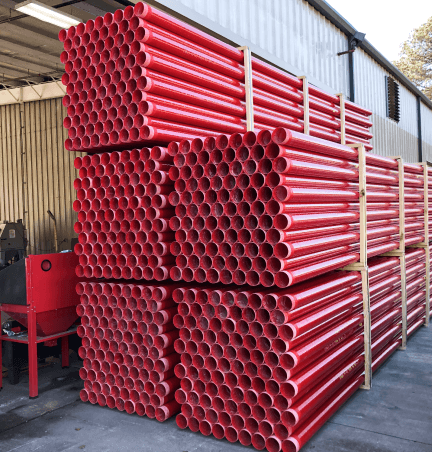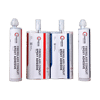By Scott Patchan
- Environmental challenges matter: Exposed conduit faces UV, temperature extremes, corrosion, and physical impact – factors that demand durable, code-compliant materials.
- Fiberglass RTRC outperforms traditional options: Compared to PVC or metal, fiberglass conduit offers lightweight handling, superior corrosion resistance, and wide temperature tolerance for bridges, coastal projects, wastewater treatment, utility, and industrial projects.
- Real-world proof: Case studies from bridges, coastal piers, utilities, data centers, and industrial facilities show how fiberglass conduit reduces weight, speeds installation, and lowers long-term costs.
In applications where exposed conduit may be present there are several special considerations that project managers and engineers must consider.
When conduit is exposed, electrical wiring systems may be left vulnerable to environmental damage due to temperature, UV exposure, and corrosion depending on the conduit type used for a project.
Applications where exposed conduit is present include bridges, wastewater treatment plants, coastal piers, and utility projects.
Exposed Conduit for Bridges and Transportation Projects
Exposed conduit applications on bridges benefit from reduced overall weight, and ease of installation, without sacrificing strength. Depending on the region, heat tolerance and temperature rating on the conduit may also be important.
PVC conduit systems are known to have a limited temperature range, which can impact field handling during installation and overall performance during the product’s lifecycle.
Traditionally, galvanized rigid steel (GRC) or PVC-coated rigid metal electrical conduit were commonly used in bridge projects. Today, epoxy fiberglass conduit (RTRC) has grown in use thanks to several advantages including light weight for easy field handling and superior corrosion-resistance.
For bridges in cold-weather regions, fiberglass conduit offers a wide temperature range of -40° to +230 °F allowing for year-round installations. Additionally, unlike PVC conduit, fiberglass conduit does not get brittle in cold weather.
See it in action:
The Seventh Street Bridge, which routes downtown Pittsburgh’s power supply, replaced aging GRC conduit with custom colored RTRC conduit in 2016.

Caustic Environments: Wastewater Treatment Centers and Chemical Plants
Wastewater treatment facilities are especially caustic, damp, and prone to extreme temperatures. Conduit exposed to these conditions must be durable and corrosion resistant.
Fiberglass conduit is resistant to a wide range of chemicals commonly found in these facilities and can be used in place of PVC-coated steel in applications where the existing conduit has begun to fail.
Chemical plants face similar corrosion challenges, and may require a non-metallic conduit solution. Again, epoxy fiberglass (RTRC) conduit can offer long-lasting protection within these hazardous environments.
See it in action:
Fox Metro Wastewater Treatment Center replaced its corroded PVC-coated rigid steel conduit with fiberglass conduit to gain versatility, flexibility and corrosion resistance for years to come.

UV-Resistant Conduit for Coastal Applications
Conduit systems installed in coastal environments are exposed to sun, saltwater, floating debris, and extreme weather. UV stability and impact resistance are especially important considerations when selecting an electrical conduit type for port authority and other coastal applications.
Haz Duct® maintains its mechanical properties within an extended range of temperatures from -40℉ to 230℉ and won’t degrade despite prolonged direct sunlight exposure.
Considerations in these environments may also include weight restrictions on piers and installation challenges over sand and water.
See it in action:
When Hermosa Beach Pier upgraded its lighting to meet dark sky compliance it also extended the lifespan of the electrical conduit system by switching from PVC-coated steel and GRC to corrosion-resistant Champion Strut™.
Large Scale and Elevated Settings: Commercial and Industrial Projects
Exposed conduit can commonly be found in large scale commercial and industrial projects. In these settings, engineers and project managers must also give consideration to regional factors including temperature and UV exposure when exposed conduit is present.
Temperature rating is of particular importance in northern climates where cold weather can make some materials (including PVC) extremely brittle.
In applications where exposed raceways are present on a rooftop, additional heat will be added directly to the conduit, and as such conductors must be derated due to the additional heat exposure (refer to the National Electrical Code for details).
See it in action:
At the Niagara Falls Observatory, using PVC-coated steel instead of RTRC would have resulted in more than 30,000 lbs. of additional conduit material and a truly hefty challenge for installers.

Exposed Conduit in Utility Applications
The United States depends on the electricity its power grid delivers across seven million miles of transmission and distribution lines.
As with other applications discussed above, temperature ratings are particularly important for utilities which require optimum and uninterrupted performance. Compared to PVC Schedule 40 and Schedule 80’s temperature range of just +40℉ to +150℉, fiberglass conduit offers an extending range to -40 to +230℉ and is UV Stable per UL 2515 & CSA C22.2 No. 211.3-96.
See it in action:
Located 12 miles from the Apalachia Dam at the base of a steep-walled gorge along the Hiwassee River between mountain formations, the TVA Apalachia Powerhouse installed Champion Fiberglass conduit to meet the project’s requirements for a low-maintenance, UV-resistant, and corrosion resistant system.
Cost can be a significant determining factor in these applications. Per the NECA Manual of Labor Rates, RTRC fiberglass conduit offers both lower materials and labor costs for projects.
Copper and cable theft may also pose unforeseen challenges to exposed conduit in utility applications, with some losses reaching 10,000 feet of cable per month. After extensive testing, fiberglass conduit was found to be strong enough to successfully protect cables, while keeping installation costs down.
See it in action:
A major Southeast Texas utility solved its growing problem of cable and copper theft with durable, easy to install, Champion Fiberglass pole risers.

Choosing an Electrical Conduit for an Exposed Application
Specifying the right electrical conduit is key to the longevity of an exposed conduit application.
Rigid metal conduit such as galvanized steel is especially susceptible to corrosion and failure over time, which can lead to costly repairs when exposed in caustic, coastal, or outdoor installations.
Flexible metal conduit is approved for exposed applications but is not permitted for wet locations, and would not be appropriate for damp environments of outdoor applications.
Rigid PVC has limited use in exposed outdoor applications due its poor UV stability and high coefficient of thermal expansion.
Fiberglass conduit (RTRC) is approved for exposed use and offers superior temperature ranges, UV stability, and impact-resistant durability making it a safe choice for many exposed conduit applications.
In addition to reviewing and complying with all NEC (National Electrical Code) requirements, installers should also review local code requirements.

Learn more about above ground conduit applications and standards
For more information about the fiberglass conduit (RTRC) uses and applications mentioned above please get in touch with a local Rep or Contact Us directly.
This article was originally published on December 8, 2022 and recently updated with new and helpful information.












